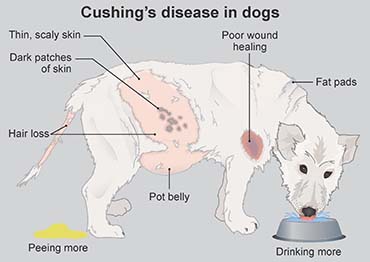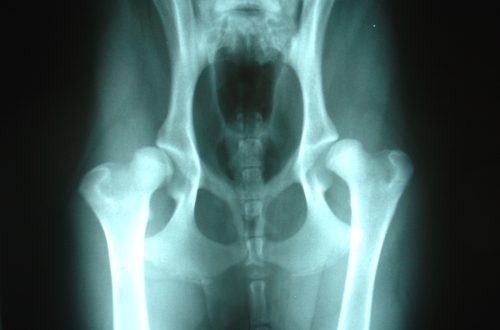
Cushing’s Syndrome (Fragile Skin Syndrome) in Dogs
The dog’s body is a unique system with numerous biochemical processes. The level of physical and intellectual development of the animal depends on their quality. The hormonal background is affected by the proper functioning of the internal secretion organs. And if an endocrine disruption occurs, the dog can get Cushing’s syndrome.
Contents
Causes of the disease
Cushing’s syndrome in dogs is one of the most common hormonal disorders. With it, there is an increased formation of glucocorticoids produced by the adrenal glands. Most often, dogs older than 7 years old suffer from the syndrome, but young dogs can also be affected. The main causes of the disease are:
Tumors of the pituitary gland. It stops producing the hormone ACTH in the right amount and cannot control the level of cortisol in the blood. This form of fragile skin syndrome occurs in 85-90% of dogs.
Tumors of the adrenal glands. In this case, an excess amount of cortisol is produced when the dog gets into critical situations and becomes very frightened. Excess or lack of cortisol is a direct path to the development of serious pathologies in the animal’s body. Pathology of the adrenal glands is more common in older dogs at 11–12 years of age.
Secondary change (iatrogenic hyperadrenocorticism). It occurs due to long-term treatment of allergies, dermatitis and severe inflammation with large doses of hormonal drugs from the glucocorticoid group.
How to recognize and treat Cushing’s syndrome
The disease begins with quite pronounced symptoms:
- frequent urination, in which the dog cannot tolerate and urinate at home;
- strong and unquenchable thirst;
- weakness, lethargy, apathy, drowsiness;
- increased appetite with eating even inedible objects;
- sagging abdomen due to muscle atrophy;
- hair loss on the abdomen and sides;
- weight loss or weight gain with a standard diet;
- lack of coordination;
- hormonal disruptions: stopping estrus in females and atrophy of the testicles in males;
- changes in behavior: an affectionate dog becomes nervous, aggressive.
This disease is quite insidious, as it is accompanied by various complications: arterial hypertension, diseases of the kidneys and urinary tract, diabetes mellitus, osteoporosis, disorders in the reproductive organs.
Breeds such as shepherd, dachshund, beagle, terrier, poodle, labrador, boxer are predisposed to Cushing’s disease, so the owners need to be periodically tested for the detection of this pathology. Most often, the disease overtakes dogs of large breeds weighing more than 20 kg. Diagnosis is made by a veterinarian and may include physical examination, clinical and biochemical blood tests, urinalysis, X-rays, MRI of the pituitary and adrenal glands, ultrasound, and screening tests to determine the level of cortisol in the blood. For treatment, the veterinarian uses medical and surgical methods:
In the first case, a doctor may prescribe drug therapy to control cortisol levels.
In the second case, he may remove one or both of the adrenal glands and put the dog on hormone therapy.
In advanced cases, a veterinarian may prescribe lifelong therapy. A sign of a pet’s recovery is a decrease in appetite and normal water intake. If treatment is not started in time, the dog may die from exhaustion.
Can a person get Cushing’s disease?
Cushing’s disease can overtake not only dogs and cats, but also people, but it is not a contagious disease. The clinical manifestations of the syndrome in dogs and humans are very similar: in humans, abdominal obesity also occurs, skin changes and muscle atrophy appear. If the disease is started, a person can lose muscle and bone mass, develop hypertension, type 2 diabetes, and become infected with unusual infections. For children and adolescents, this is a rather rare diagnosis.
How is Cushing’s disease different in cats and dogs?
Unlike dogs, Cushing’s syndrome is rare in cats.
One of the differences in the clinical manifestation of the disease is poorly controlled diabetes mellitus with severe insulin resistance. The skin becomes thin and fragile, the cat quickly loses weight.
The second difference is non-overgrown hair after shearing, baldness in the tail and withers.
The third difference in the disease is the formation of skin calcifications in dogs on the neck and ears, which does not occur in cats.
How to prevent disease
Only the iatrogenic form of Cushing’s disease in dogs can be prevented by a moderate dosage of hormonal drugs in the treatment. In no case should you prescribe such treatment yourself – you must pass all the tests and consult with a veterinarian. In any case, owners should monitor the condition of the dog’s coat, changes in appetite, increased thirst and hair loss, and if any symptoms appear, contact a veterinary clinic. All these signals will help to identify the disease in time and keep the pet healthy and alive for several more years.





